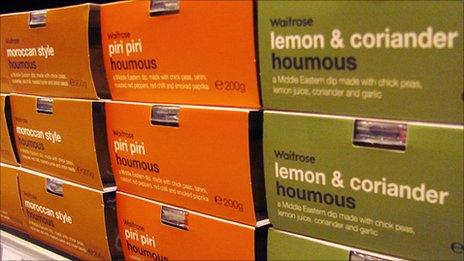How hummus conquered Britain
- Published
- comments

In a quarter of a century hummus has gone from fringe food to a staple in British supermarkets, so is its adoption a sign of changing tastes?
Once upon a time in the West it was an ethnic delicacy with a hippy following.
This ancient peasant dish - usually of cooked and mashed chick pea, tahini (sesame paste), lemon and garlic - hails from the countries of the eastern Mediterranean, where unleavened bread is used for dipping.
But like chicken tikka masala and spaghetti bolognese before it, hummus has been co-opted into Britain's cosmopolitan national cuisine. It has moved beyond the Lebanese or Turkish delicatessen to plastic pots taking up row upon row of the supermarket chiller cabinet.
There is disagreement over how to spell it - hummus or houmous - but no debate over its rising popularity. Britain gets through 12,000 tonnes of the stuff a year, worth over £60m, according to consumer research firm Kantar Worldpanel.

Hummus at Jerusalem Gate, a Lebanese restaurant in London
A New York Times article last year reported that it had gone from a $5 million-a-year US market in 1995 to one worth $325m.
Waitrose is thought to have been the first British supermarket to stock hummus, introducing it in the late 1980s. Marks and Spencer followed suit in 1990 and today four of its top five selling dips are hummus. Tesco, which began selling it in the late 90s, now sells over 30 million pots a year.
Recently it has moved beyond its core ingredients to embrace flavours such as red onion, lemon and coriander, roasted tomato, Moroccan topped, red pepper, piri piri, and broad bean and asparagus, as well as organic, low fat and extra rich versions. Waitrose, Sainsbury's and Tesco sell 12, 13 and 21 lines of hummus respectively.
In the US, you can buy peanut butter, pizza and chocolate mousse flavoured hummus, while Austria offers curry, wasabi and beetroot versions.
Other Middle Eastern dishes are popular in the West, such as taramasalata, tzatziki and falafel. But none enjoys the ubiquity of hummus. Consumer consultant Philip Graves says the dip has taken off because it is "moreish" and convenient.
"Certain foods become a hit because of their particular balance of fats and salts or fats and sugars. Physiologically they're very moreish and hummus fits this pattern."
It is a food for the convenience era - the age of the ready meal of dubious health value. Hummus, on the other hand, seems to the consumer to be pre-prepared, instant food that feels fresh and healthy, Graves says.
Its healthy image is based on the fact that it is relatively high in protein for a carbohydrate, contains little saturated fat and has a low GI value. The NHS website recommends it to pregnant women.
Hummus's path to mainstream acceptance in Britain already stretches more than half a century. The first person to write about it in English was the cookery writer Elizabeth David in 1955, with her book Mediterranean Food. Her biographer, Lisa Chaney, says that David created the climate for hummus to flourish amid post-war Britain's dour food culture. Above all, she valued the sensuality of simple peasant food that respected the seasons.
"Her first books had Middle Eastern recipes that were almost unheard of in those days," says Chaney. "And you don't get anything more elemental or peasanty than the chick pea."
Food historian Ivan Day first encountered hummus in Britain in the late '60s in a Greek restaurant in Soho. At that point it was only in the Greek Cypriot, Lebanese and Turkish communities where hummus was eaten.
In the 1970s more and more people started going on holiday to the Greek islands, Cyprus and Turkey. They came home with new tastes and with few British shops selling hummus, some of them began making it themselves.
Then in the mid '80s it began to appear in supermarkets and in the '90s was boosted by a boom in consumption of dips. Hummus's penetration of Britain is today complete, says Day.
"Now when you go into a rural supermarket you see hummus in the chiller cabinet. Ten years ago if you'd asked an employee they wouldn't have known what you were talking about."
However, it is bounded by class and age. Research by Kantar Worldpanel shows that hummus consumption is dominated by social classes ABC1 and tails off in those aged over 44.
Christian Mouysset, who launched the restaurant chain Hummus Bros in 2005 with fellow Cambridge student Ronen Givon, says the chick pea paste is moving away from its "hippy" dip image. The chain, which hopes to double in size to six branches next year, serves hummus as a staple food accompanied by chicken, beef, guacamole or beans.
"Nobody used to see it as a main meal, it was a dip. But in the past three years people have elevated it to a 'smart carb' that is the basis for a meal."
Times food columnist Alex Renton says hummus follows in the footsteps of pesto: "We imported it, adapted it and now the people who invented it wouldn't recognise it."
Pesto, a simple sauce of basil and pine nuts, has been reinvented and "improved" to such an extent that Britain now sells pesto with sun-dried tomatoes back to Italy, he says.
"There's a grand tradition of taking peasant food from around the Mediterranean and making it posh food here. Most Brits who ordered hummus in Tel Aviv wouldn't even like it."
Taste is a delicate subject though. The burghers of Beirut may not be quite ready to see their beloved hummus laced with pizza, beetroot or chocolate mousse.